
- Home
- Memories
- Scrapbook ▽
- Topics ▽
- People ▽
- Events
- Photos
- Site Map
- Timeline
There was an Iron-age settlement in South Western Southernhay which, it is thought, was occupied until the Romans invaded. It was excavated during 2002/3 when the site was cleared for the new County Courthouse. The Celtic tribe called Dumnonii had a settlement in the area of Bartholomew Street . There is evidence from coins that the Dumnonii in Exeter trade with Mediterranean peoples, including the Greeks. The High Street at this time was an Iron-age trackway.
49 The Roman General Vespasian arrived with the 2nd Augustan Legion and established a wooden military fortress of 42 acres.
 0-AD
0-AD49 The Roman General Vespasian arrived with the 2nd Augustan Legion and established a wooden military fortress of 42 acres.
55 A Roman Bath House was built in Cathedral Yard - this was the earliest Roman cut-stone structure in the country. The Roman fortress was well established during this time in the area of Cathedral Yard and the top of South Street.
There is archeological evidence of clay quarrying to produce roofing tiles in the Princesshay area close to where the city wall would be built.
60 The Chief of Staff of the 2nd Legion at Exeter, Poenius Postumas commits suicide by falling on his sword after failing to obey an order to march a contingent of soldiers 200 miles to Mancetter (Atherstone in Warwickshire) to support Paulinius the Governor of Britain. It is thought, by some, that Mancetter was the venue for the final battle with Boudica and her 120,000 army of Britons. 80,000 Britons died and 400 roman soldiers. Boudica fled back to Iceni territory where she too, commits suicide.
70 approx - the Legion abandoned Exeter for South Wales, leaving a Roman administered town called Isca Dumnoniorum
Around this time a street was laid out at right angles to the High Street through the centre of Princesshay towards the city wall.
120 The first city wall was constructed along the modern line as an earth bank.
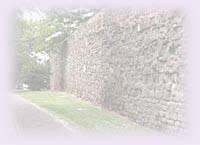 200
200200 The Roman earth bank was replaced by a stone wall along its length. The builders created a clay rampart layered with chippings of volcanic stone from the masons as they faced the wall. The street through Princesshay was re-aligned and a large Roman Town House with three ranges of rooms and a courtyard was constructed. Two rooms had hypocausts (underfloor heating), the rest had mortar floors.
Early in the 5th century the Romans abandon Britain. The town became derelict and largely returned to agriculture. The first Christian burials take place in Cathedral Yard.
450 Exeter becomes known as Moncton.
More Christian burials are attributed to the 6th century.
658 The Anglo-Saxons are established in Exeter. Wonford becomes a Saxon king's royal estate.
670 An abbey dedicated to St Peter and St Mary was founded by the Saxon King Cenwealh in Cathedral Yard. It became the Cathedral and then St Mary Major Church .
680 The young St Boniface leaves Crediton to be educated in Exeter.
During Saxon times, Exeter was called Isca Chester.
876 The Danes captured Exeter.
877 King Alfred expels the Danes, strengthens the defences and walls
880 approximately - the first coins minted in Exeter.
928 King Athelstan expels the British (Celts) from the British quarter of Exeter for it to become a Saxon town.
The city is renamed Exancaester by Athelstan.
Exeter has become the sixth most prosperous town in England.
The working of metals, leather, cloth and wood were key skills. Trading in tin and other minerals also were important industries.
1001/2 The Battle of Pinhoe in 1001 and the Viking Sweyn, raids Exeter in 1002 and burns down the Minster.
1019 Sweyne, repairs the burnt out Minster as a penance.
1050 Bishop Leofric is enthroned as the first Bishop of Exeter.
1060 St Olave's Church is founded.
1065 St Martin's Church is consecrated by Bishop Leofric.
1068 William the Conqueror takes Exeter after a siege and the building of Rougemont Castle is started.
1072 Bishop Leofric died.
1080 St Nicholas' Priory founded.
1086 Duryard is recorded in 'Domesday' as a Royal hunting estate.
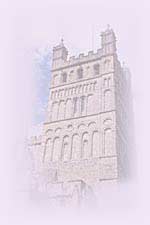
1114 Warelwast, the nephew of the Conqueror, commences work on a new cathedral.
1133 The partly complete Norman Cathedral is consecrated.
1136 King Stephen besieges Exeter Castle from Danes Castle.
1160 The Guildhall is mentioned in records for the first time.
1170 approx. A seal of Exeter, the oldest in the country survives from this time it is inscribed 'SIGILLVM CIVITATIS EXONIE' (the seal of the city of Exeter)
1180 The new Norman Cathedral is finally completed.
1202 The first mention of the Mayor is recorded.
1225 An attempt was made to open a 'school' (university) in Smythen Street. It did not progress.
1226 The first record of an underground passage to supply water to the city is made.
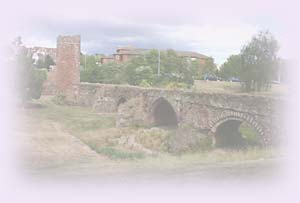 1238 The first
stone bridge over the Exe is completed by
Walter Gervase.
1238 The first
stone bridge over the Exe is completed by
Walter Gervase.
1270 Work started on the Lady Chapel at the Cathedral.
1280 The rebuilding of the Cathedral apart from the Norman towers commences under Bishop Quinel.
1283 Walter Lechlade murdered in Cathedral Yard.
1284 Countess Isabella de Fortibus builds a weir at Countess Wear for her mills that impedes the River Exe for navigation.
1285 Edward I visits Exeter to preside over the murder trial of Walter Lechlade.
1286 Cathedral Close created with a 12 ft high wall and seven gates.
1311 Hugh de Courtenay blocks Countess Wear completely to increase trade through the port of Topsham.
1327 Work on the West Front of the Cathedral commences.
1330 The old Guildhall in the High Street is rebuilt.
1348 The Black Death reaches Exeter - many of the craftsmen involved in building the Cathedral die.
1348 Exeter's Bishop stopped 'The Order of Brothelingham' from performing in the street. This is the first known reference to theatre in Exeter in Exeter.
1354 John Weekes, the first Recorder of Exeter was appointed
1369 The rebuilt Cathedral is dedicated on November 21st.
1435 Wynards Almshouses are founded.
1466 The Guildhall is re-roofed.
1471 Tucker's Hall in Fore Street is built.
1497 Perkin Warbeck besieges the city and is beaten off. King Henry VII visits the city and presents his Sword and Cap of Maintenance as a gift in thanks for their loyalty. See East Gate Henry VII Statue
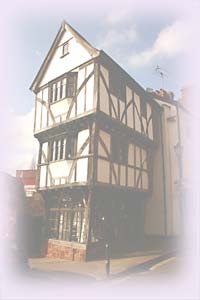 1500
15001536 St Nicholas' Priory is closed and part demolished by order of Henry VIII.
1538 Henry Courtenay is executed for conspiracy - his lands are confiscated with Exe Island given to Exeter and orders that Countess Wear is to be removed.
1537 Henry VIII makes Exeter the County of the City of Exeter and the first Sheriff is appointed (loses county status in 1972)
1549 The Prayer Book Rebellion - Exeter is under siege from Catholics enraged by the abandonment of their religious customs.
1554 Richard Hooker, who wrote on Protestantism was born in Exeter.
1563 The building of Exeter Canal is started by John Trew as clearing Countess Wear did not allow navigation to Exeter.
1570 Radford Place (House) was built by Lawrence Radford - it lends its name to the area, Mount Radford.
1588 The Armada is defeated by an English fleet. Topsham supplied and equipped three ships The Rose, The Gift and The Bartholomew. John Dyer negotiates Exeter's contribution to the cause in Mol's Coffee House.
1596 The front of the Guildhall is remodelled and the Beer stone columns erected.
1633 The Free Grammar School is founded - this becomes Exeter School in the 19th century.
1642 The English Civil War breaks out - Exeter comes under siege from the Royalists.
1644 Princess Henrietta Anne, youngest daughter of Charles I born at Bedford House during the siege of Exeter by Parliamentary forces during the Civil War.
1646 Exeter surrenders to the Parliamentary forces of General Fairfax at Poltimore House
1676 Exeter Canal is extended to Topsham and trade through the quay grew.
1680 The Customs House, the earliest brick building in Exeter is built, as trade through the quay expands.
1688 William of Orange passes through Exeter on his way to claim the throne.
1698 Celia Fiennes visits Exeter when on her journey around England
1704 Exeter's first newspaper, the Exeter Post-man from Sam Farley is published.
1721 The Seven Stars in Okehampton Road put on its first theatrical performance.
1727 Daniel Defoe, author of Robinson Crusoe visits the city during his three year tour of Great Britain.
1735 A purpose built theatre opened in Waterbeer Street *. See theatre in Exeter
1739 John Wesley preaches at St Mary Arches Church
1743 The Royal Devon and Exeter Hospital in Southernhay opens.
1769 The Northgate is removed.
1770 The Royal Clarence Hotel the first 'hotel' in the country opens in Cathedral Close.
1778 The new Georgian Bridge over the Exe opens.
1786 The first balloon ascent from Exeter
1787 The New Theatre opened in Bedford Circus. See theatre in Exeter
1790 Bodley and Co, the foundry in Commercial Road is founded
1802 The building of Colleton Crescent by Matthew Nosworthy commences.
1819 The Southgate at the bottom of South Street is demolished.
1820 The New Theatre burnt down. See theatre in Exeter
1821 The Theatre Royal is built on the site of the New Theatre.
1824 Pinder and Tuckwell the outfitters are founded
1827 The Royal Clarence Hotel is named, after the Duchess of Clarence stays there.
1830 The canal basin is built by James Green.
1832 A cholera outbreak hits the West Quarter and parts of St Thomas.
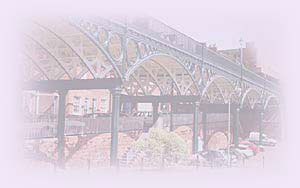 1834 The Ironbridge is constructed
across the lower Longbrook valley.
1834 The Ironbridge is constructed
across the lower Longbrook valley.
1840 Queen Street is completed.
1844 The railway from Bristol opens at St David's Station . A National School next to St James Church is founded - this becomes St James' High School in Summer Lane .
1845 Heles Grammar School for Boys is founded.
1847 Brunel's Atmospheric Railway runs between Exeter and Newton Abbot
1860 The Southern Railway reaches Exeter with a station below Northernhay Park.
1869 The Royal Albert Memorial Museum is built - Eland the stationers is founded.
1885 The Theatre Royal in Bedford Circus is burnt down. See theatre in Exeter for an account. A replacement is quickly built at the top of Longbrook Street.
1887 The Theatre Royal at Longbrook Street is burnt down with the loss of 186 lives.See theatre in Exeter
1889 Exeter's first Electricity Generation Station where Longbrook House is now situated, opens. A new Theatre Royal, the first with electric light and a safety curtain opens.
1893 With support from the University of Cambridge, the Exeter Technical and University Extension College is founded.
1896 A circus displayed the first car in Exeter
1899 St Thomas was incorporated into the City of Exeter.
1900's See The decade of the 1900's. The Royal Albert Memorial College was founded - this became the University.
1902 Queen Victoria dies. The Coronation of Edward VII is celebrated in Exeter in May 1902. The Theatre Royal shows its first moving film show.
1905 The Georgian Bridge is replaced by a new, cast iron Exe Bridge. The first electric tram runs in the city. The Buller Statue is unveiled.
1908 General Buller dies at his home in Crediton.
1910's See The decade of 1910 to 1919.
1911 The Daily Mail Circuit of Britain Air Race passes through Whipton.
1912 Greenslades, the coach company was founded. Cliff Bastin the Exeter City, Arsenal and England footballer was born in Heavitree.
1914 The Great War breaks out, and Exeter faces four years of restrictions.
1916 Deller's Cafe opened.
1917 A tram ran down Fore Street and crashed on the Exe Bridge, killing one passenger.
1920's See The decade of the 1920's.
1920 The Devon War Memorial in Cathedral Yard was unveiled by the Prince of Wales.
1925 Tommy Cooper, the future comedian and magician moved to Exeter with his parents.
1929 The Exeter Golf and Country Club relocated from Pennsylvania to Wear Farm, Countess Wear.
Work started to build Burnthouse Lane as social housing to replace the slums of the West Quarter.
1930's See The decade of the 1930's.
1931 The last electric tram runs in the city.
1935 The New London Inn is demolished and replaced by the Savoy Cinema (later the ABC) in 1936.
1938 Exeter Airport was opened on the 30th July 1938 by Sir Kingsley Wood, Minister of Aviation.
1939 In December, HMS Exeter leads the force that forces the Graf Spee to be scuttled after the Battle of the River Plate.
1940's See The decade of the 1940's

1942 HMS Exeter is sunk on 1st March 1942.
1943 The last man to be executed at Exeter prison is hung on 6th April.
1942 Exeter is blitzed in May destroying a large part of the city.
1949 The rebuilding of Exeter following parts of Thomas Sharp's plan starts, with Princess Elizabeth unveiling the Princesshay feature.
1950's See The decade of the 1950's
1955 Exeter University received its Royal Charter.
1960's See The decade of the 1960's St Thomas suffers bad flooding in 1960 in October and December.
1961 The Merchant House is moved from Edmund Street to the bottom of West Street. It is known as the House that Moved.
1962 The Theatre Royal closes.
1966 Alphington, Pinhoe and Topsham were incorporated into the city boundary.
1967 Northcott Theatre opens.
1970's See The decade of the 1970s
1972 The Onedin Line is filmed at the quay by the BBC.
1976 The BBC returned to Exeter to film the Onedin Line in March.
1980's See The decade of the 1980's
1990's See The decade of the 1990's
1997 The Maritime Museum closes and the Picture House opens.
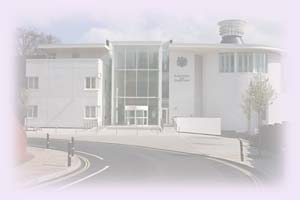 2000-AD
2000-AD2000's See Exeter in the 2000's
2000 The Peninsular Medical School was established on August 1st.
2002 On 14th June Michael Jackson (yes - the singer) visited St James' Park to support Exeter City. He was invited by Uri Geller, a director of the club at the time. David Blaine the magician was also present.
2003 The Met Office relocated from Bracknell, Berkshire to a new site in Exeter in December 2003.
2005 On 14th February, Princesshay was finally closed to allow demolition and redevelopment. See Princesshay Redevelopment for the latest progress. 17th August - an actor re-enacted the journey of Lt Lapenotiere from Falmouth to London with the news of the victory at Trafalgar and the death of Nelson.
2006 Vue, a new multiplex cinema, in Belmont Road opens in December.
2007 The Devon and
Dorsets parade for the last time and their colours laid up in the
Cathedral. The Rifles are formed from several regiments, including the
Devon and Dorsets.
Debenhams closed on the 15th September, ready to move to its new
store
in Bedford Street. See Debenhams last sale.
2008 On 22 May at the Giraffe cafe and restaurant in Princesshay there was a failed bomb attempt
│ Top of Page │